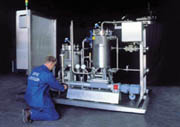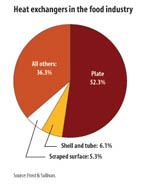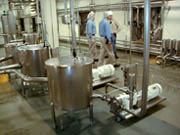
Since they first were applied to dairy processing more than 80 years ago, heat exchangers have expanded to a wide range of food applications. Their ability to turn labor-intensive batch processes into automated continuous processes has enabled these thermal workhorses to extend into industries such as pharmaceutical, health & beauty aids and petrochemical production.
This year, North American industry will invest $2.1 billion in heat exchangers, analysts at Frost & Sullivan estimate, to perform the tasks of cooling, heating, distilling, evaporation and condensation. The food and beverage segment will focus most of its spending in three broad categories: plate-and-frame, shell and tube and scraped surface heat exchangers, with prices escalating along with viscosity levels handled. A higher price brings a higher level of engineering expertise, and some of the supplier community's most technologically sophisticated companies fabricate scraped surface units. However, their price tags and relatively high maintenance costs make them a solution of last resort. Sales of scraped surface heat exchangers to food, beverage and dairy firms will increase at a 1 percent compounded rate over the next seven years, Frost & Sullivan's Michael Rasche believes, while shell and tube will grow 1.2 percent. Plate heat exchangers, the most common devices (see chart on page 47), will enjoy 3.9 percent compounded growth, according to Rasche.
The state of Wisconsin is dotted with fabrication shops manned by spot welders with the stainless-steel expertise to build plate and tube heat exchangers. Convinced this equipment had become a commodity, Waukesha Cherry-Burrell (WCB) elected in 2001 to sell its tubular and plate production capabilities to Thermaline Inc., Auburn, Wash., and focus exclusively on scraped surface machines.

Improvements also are being introduced to plate heat exchangers. Invensys has engineered the first PLC-equipped unit to eliminate operator involvement in the opening and closing of machines for visual inspection, and Alfa Laval is pushing the thermal envelope with gaskets that can withstand process temperatures exceeding 300

Dynamic action
Scraped surface heat exchangers have been around almost as long as plate-WCB's Ray Klusman traces the introduction of the Votator model to the 1930s-but the versatility of today's machines far surpasses the early designs. Shortening was scraped's proving ground; now the technology is successfully applied to peanut butter and other highly viscous products, as well as heat-sensitive foods. "It's like a car: it still has four wheels," says Klusman, but functionality has expanded exponentially.The same may be said of contemporary tubular systems, counters APS's Csizmadia. Advanced pumping technology and improved design of tubes' heat-transfer surfaces have resulted in strong, consistent product turbulence with a minimum of pressure drop. As a result, tubular systems are being applied to more viscous foods, giving processors an option to scraped surface systems.
APS is a six-year-old firm based in Jeffersonville, Ind., and operated by former Cherry-Burrell employees. The firm engineers plate and scraped surface systems for clients, but the focus is on tubes. APS engineers were involved in the aseptic installation at Hunt-Wesson's Waterloo, Ia., pudding facility, Food Engineering's Plant of the Year in 1999. More recently, the company engineered the triple-tube aseptic piping at Gerber's Fremont, Mich., baby-food plant. Two coil configurations for pudding processing were installed this year at Gehl's Guernsey Farms, an aseptic dairy processor in the Milwaukee area.
The Hunt project represented the first time an all-tubular line was used for pudding, which until then was an all-scraped process, Csizmadia says. "Ten years from now, I don't think there will be any pudding running on scraped." He credits the switch from dimpled tubes, which tend to cause product flow rates to fluctuate, to corrugated designs for opening more opportunities in particulate processing for tubular systems. Reduced sheer means products like bean soup survive an aseptic process without being reduced to mush.
Validation work remains to be done before those types of tube-processed products reach the market. In the meantime, scraped surface remains the industrial standard. Their ability to process peanut butter and fruit fillings with particulate that still look like chunks of fruit is unrivaled.

Product contamination also is a constraint on material choice for the heat transfer tube. Nickel optimizes heat transfer, but it has the unfortunate tendency to flake when scraped. Corrosion also is an issue, particularly with harsher CIP chemicals. Extensive R&D is being invested in various alloys of nickel, stainless steel, titanium and aluminum, and engineers are investigating other solutions. Alfa Laval's answer is Alfaloy, a diamond-hard coating which also minimizes the likelihood of microscopic surface cracks that require maintenance. The coating boasts a Rockwell hardness rating in the low to mid 90s, compared to low 70s for uncoated surfaces, according to Martin.
Alfa Laval's scraped line 6X11 unit features a 6 in. diameter tube with 11 square feet of processing surface.
Terlet Inc.'s T2 scrape system has 47 sq. ft. of transfer surface. The unit, called the Terlotherm, is fabricated in the Netherlands and was introduced to the North American market in the early 1990s, according to Alan Ferraro of Pennsauken, N.J.-based Terlet. Smaller versions also are made.
The largest unit has 48 scrapers in six rows and has fewer moving parts than other scraped surface machines, according to Ferraro. The other distinction is shaft rotation: while 350 RPMs is typical in competing units, Terlet's machine operates in the 60-80 RPM range. "Shear is much lower in our units," he points out.
Sheer volume
Tube size allows the unit to process particulate up to one inch, slightly larger than WCB's Votator II machine, and lower RPMs means less mechanical heat is introduced to the product, a benefit when chilling is being done and crystal formation poses a problem. In that situation, WCB would specify lower RPMs when defining the process, which would also lower throughput. Otherwise, rapid shaft rotation is a plus, explains WCB's Klusman, because "high RPMs give better heat transfer.""We're finding new blade materials, new techniques for defining product parameters, new products such as low-carb formulations that require alterations to the equipment," he reflects. Perhaps the most significant change is the enhancement in process control: "Years ago, systems were mainly manual," says Klusman. "In most applications today, operator input is nonexistent because we define the process."
Control technology is impacting plate units, as well. Invensys's APV division recently upgraded its hydraulically powered unit with a PLC that takes the guesswork out of precision closing of the machine after inspection. The first Quad Drive went into service in January at egg processor Rembrandt Enterprises Inc., Rembrandt, Ia. Visual inspections to verify proper CIP sanitation are conducted daily. The procedure meant an employee spent "maybe 30 to 45 minutes a day, watching the unit open and close," recalls JT Dean, Rembrandt's processing manager. Potential damage to bearings, gaskets and plates posed maintenance challenges and potential downtime scenarios. When piping contractor Central States Industrial in Springfield, Mo., told Dean about Quad Drive, he went to see it for himself at last fall's Worldwide Food Expo and ultimately purchased the floor model.
"Instead of four people doing setup in the morning, we went to three with the new press," says Dean, who estimates payback within 12-18 months. "With the old model, two screws extended out from the frame when you opened it, which meant keeping almost five feet of floor space open." The new unit's tie rods remain in place, freeing up floor space.
Approximately 400 hydraulics-driven plate-and-frame machines have been put into service in the United States by APV. Though most dairies go extended periods without opening up their machines, some take a conservative approach to hygiene verification and inspect the plates every few months, according to Derek Finch, an Invensys design engineer. Several hundred plates are mounted on some frames, and closing the units to the correct gasket compression becomes a two-person operation. One worker measures the amount of compression while another pushes a button. Imprecise closing sometimes occurs, and plate damage from excessive compression force is not unheard of.
"With the PLC, you can hit the close button and walk away from the machine," Finch says. The controls should extend gasket life beyond a three-years recommended maintenance cycle, a significant savings when new 1,000-plate heat exchangers measuring 27 ft. long come into the market.
Both hydraulic and manual machines are being equipped with the quad-drive frame. Four tie rods that guide the follower toward the head of the machine are controlled by a single chain-and-sprocket system to synchronize the movement and maintain the 180